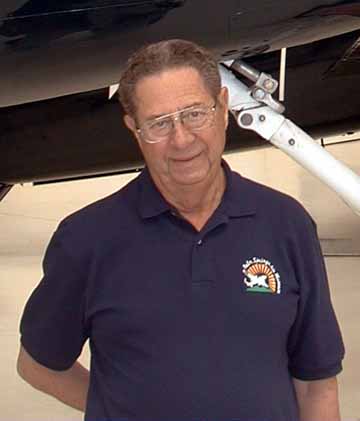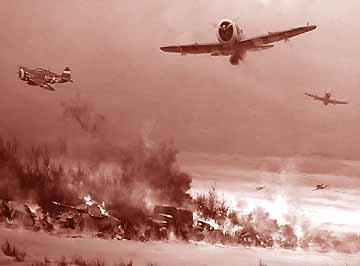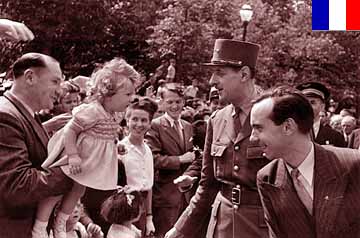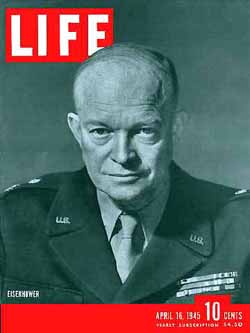Sandy Hirschhaut
BAR Gunner Normandy

Webmaster: When were you born?
April 1, 1921
Webmaster: Where were you born?
Hartford, CT. The funny thing about my birth, my mother did not expect twins. So on April Fools Day, she got fooled.
Webmaster: Who was the surprise?
My sister, I came first. It was the only time in my life that I ever beat my sister at anything.
Webmaster: You grew up in Hartford, school and high school?
Yes
Webmaster: You were telling me earlier that you were attending college?
I went to a very small school in Springfield, Mass. American International College or AIC. We said that stood for, "Almost In College."
Webmaster: You were interested in the Submarine Service and this was prior to Pearl Harbor?
Hartford is 52 miles from New London and Electric Boat (US Submarine Works). We always summered in New London and, as a youngster, I was familiar with the work of Commander Edward Ellsburg who was famous for raising submarines. The S-15 and the S-4 are two I remember quit well. So I became interested in his books and the Submarine Service in general. It was dangerously exciting and I was hooked.
Webmaster: While you were in college, you decided to enlist in the Sub Service
Just after December 7, I decided I wanted to get in the Navy and Sub Service so I told my dorm mates that I was going to New London to enlist and we had a big party that night. The next day I drove to New London and applied. After the physical, I was told that I did not qualify for submarine duty because of my eyes. They added, or any service in the Navy because I could not see well enough to serve as lookout. They suggested I look into the Marines. I said, "I may be dumb but I'm not stupid."
Instead of going back to school the next day because of the wild "going away" party we had and big occasion they made out of it. I decided not to return to school and wait until the next semester. In the meantime, I was drafted.
Webmaster: You mentioned December 7, 1941, did Pearl Harbor motivate you to go in?
Yes, I never thought about going into the service at all until Pearl Harbor. I felt it was the right thing to do and the right time to go. I wanted to get in and do my part.
Webmaster: You were 21 years old at the time?
Yes.
Webmaster: When were you drafted?
September 11, 1942.
Webmaster: Being drafted meant, more than likely, Army Infantry?
Exactly, no choice, Army Infantry.
Webmaster: Where did to do your Basic Training?
Camp Croft, South Carolina. From there I went to OCS at Fort Benning, GA. From there I was dismissed for lack of military experience. I forgot to "sir" all to often and a few other infractions. I spent some time at a camp in Pennsylvania processing and was assigned to the 29th Infantry Division in England.
Webmaster: What Regiment?
The 115th, F Company, 3rd. Platoon.
Webmaster: At that time, Eisenhower was not Supreme Allied Command?
That's right. I believe he was a colonel in North Africa. He had a title there but I don't remember what it was.
Webmaster: You ship off to England some time in '43. I would assume that the D-Day Invasion was in the planning stages?
That is exactly what we did. We were in northern England close to Scotland where we were stationed. I remember a lot of rough terrain. I qualified with an M1 rifle several times as an expert. When I got to division, they decided I was going to be a BAR rifleman. That's Browning Automatic Rifle.
Webmaster: Do you remember what your weight was at that time?
Around 130 pounds.
Webmaster: I always heard that when they picked someone to carry the BAR, they always picked on the smaller guys--never the big guys--and that thing was heavy?
I don't understand it. I don't know why I was picked. I was pretty slight but in great shape. I'm trying to remember the weight of the thing. It was around 30 pounds. I was a corporal and had two PFCs who carried M1s along with my ammunition.
When you fired an automatic rifle, you would draw enemy fire especially mortars because they did not like that weapon and wanted to take it out as quickly as possible. We were trained to fire in bursts of six rounds. More than that, the barrel would overheat.
Webmaster: You trained in northern England and during that time, I assume they were building up your overall force for the invasion?
When I got to the 29th Division, it had already been formed and trained in the United States. I was a replacement. Most of the guys in that division were from Pennsylvania and surrounding states. I was stationed in Sharon, PA and that may have been the reason why I was sent to the 29th. I don't remember any other Connecticut people in the 29th.
Webmaster: You arrived at the 29th six months or so before the invasion and trained constantly. All you guys knew you were going to invade?
We knew there was going to be an invasion. We knew what we were there for. Training on landing craft made it very clear. Our approaches to the English beaches and the way we got into defensive positions after we hit the practice beaches. We looked for cover and concealment and readied our firearms for any attack from the enemy.
Webmaster: D-Day comes along and you were transported from northern England on trains?
No, we were transported by trucks to South Hampton.
Webmaster: And then you boarded US Navy Ships?
There's another story. We were trained in Landing Craft Miscellaneous otherwise known as Higgins Boats which had a wide ramp for us to exit when we hit the beach. After all this training in this small craft, I ended up on an LCI which was Landing Craft Infantry instead of a big wide ramp that you could scramble off of and run like crazy, we had two narrow, one-man ramps on each side of the bow. We were not trained on how to get off an LCI. It made it interesting. The Germans were much more interested in getting the high volume boats with the wide ramps so they kind of left us alone because we were coming out single file.
Webmaster: When you came across the Channel, you circled?
No, we came across halfway and stopped. The boats that circled were carrying men who came down landing nets from large ships.
Webmaster: Which beach did you hit?
Omaha.

My two ammo carriers and I were some of the first off the LCI. I saw the mess on the beach. The water was bloody, the sand was bloody, dead and wounded all over the place. Even though we were in the first wave a few had come before. I decided right away, despite our training, I wasn't going to find a defensive position in that sand. In front of us, about 30 yards, was a very steep mound and I decided I was going to get to that mound as fast as I could. If the other guys followed me, fine, but I was going to get there and get out of the line of fire. It was just as well because there were no targets we could see. We stayed there the better part of the day until they could get more troops on the beach and then we moved out.
There was a lot of shelling from the ships that went over us. We were not endangered by it. They were still trying to take out the beach defenses.
Webmaster: From there, where did you go?
We fought through the hedge rows. We advanced in very small increments. These hedge rows were 8-10 feet high--poplar trees I think. They were very old and their roots were entwined and very difficult to get through.
Webmaster: This was in June. You pushed to St. Lo?
Yes, this was about half way to Paris. It was three weeks after we hit Omaha. St. Lo is an old city built on a plateau. The Germans were on top of the Plateau with 88s. A big accurate canon and probably the best weapon of the war and they were shooting down at us. I had said to the Lieutenant I had enough of the BAR. I said, "I quit." He said, "Corporal, that's alright, no problem, we will put you somewhere else." So he put me in mortars. The bad thing about mortars is that after you fire a few rounds, the Germans would throw everything they had at you. There were six of us servicing this mortar when we heard a round from an 88 coming in. Everyone hit the ground and it landed very close to us. It picked me up several inches off the ground and slammed me back to the ground. There was no external damage but it did damage a kidney and I was bleeding. Several of our people were wounded and one or two were killed.
Webmaster: How far away from you did that shell hit?
I didn't stop to measure it but I would guess somewhere from 15 feet to 30 feet. Close enough to hurt.
They sent me back to England where I spent several days in the hospital.
Then I got the biggest break of the war. I was assigned to Supreme Headquarters. We called it SHAFE, Supreme Headquarters Allied Expeditionary Forces. An organization composed of British and American Troops.
Webmaster: They had military representatives from all those countries in SHAFE?
Yes, G1 had a British Officer in command and his second-in-command would be an American. G2, which was intelligence, also had a Brit in command.

Webmaster: Eisenhower was overall commander then?
Yes.
Webmaster: This was the fall of '44.
Yes, maybe as late as November.
Webmaster: So how did you end up in the Ardennes Forest?
Part of our task was to protect intelligence people who were sent out on missions. We had a group of British and Americans who would go out and gather information from German prisoners and also our people who were returning from the front. These G2 people would gather information and radio back to Paris where SHAFE was. Actually it was located at Versailles. Our job was to protect those people. We had Army people whose job was to protect the perimeter of our encampment. Our job was to protect the people and papers.
We were ordered to go to Spa, Belgium which is about 12 kilometers north east of Bastogne. Our task was to gather information from that area, which was considered to be a safe area and send it back by wire to Versailles. We heard some cannon fire coming in. We radioed our concerns and were advised that it was nothing. One day we saw German tanks coming up the valley. We burned everything we could and damaged all the vehicles. There were 13 of us and one 3/4 ton weapons carrier. We had a very exciting trip back to Bastogne. It was deathly cold, cramped and uncomfortable in that truck. They kept telling us that in the safety of Bastogne, we would be alright. It turned not to be so safe. All the other troops retreated to back to Reims, France. The few of us infantry were surrounded at Bastogne. I was lucky because I had picked up a pair of US Air Corps flight boots and my feet were warmer than anyone else.
We had a very strange incident at Bastogne. We were fighting in an apple orchard and in that orchard was a slight rise. We fought back and forth for that piece of high ground. The French and Belgium farmers always let their cows wander in the orchards and they would eat the fruit that fell on the ground. This was wintertime and there was snow on the ground. The cows would paw the ground to get at the apples. The apple trees were denuded of branches because of the war. Each tree was no more than a single branch or several branches rising from a union near the base. There was one particular tree that had a trunk several feet high and had a crotch where two branches joined several feet above the ground. There was a cow eating nearby when an 88 round came in and blasted this cow into the tree. It was caught in that crotch with its feet down and its head down as if it were looking for apples. We started laughing at that sight and we noticed that the Germans were beginning to laugh also. Within a few moments we were both laughing hysterically and this went on for about 20 minutes. After awhile things started to sober up and we started killing each other again.

Webmaster: At what point and what occurred that indicated to you that you were going to get bailed out of that mess you were in?
We heard rumors, day after day, that when the weather cleared help would get to us. Incidentally, the reason we were holed up was due to the foul weather. Tanks trying to get to us were sliding off the road. Nothing moved. Finally the weather cleared and P-47s came in and shot up the German positions. This allowed help to get to us. The P-47 has always been my favorite airplane since then.
Webmaster: When you were in Versailles with SHAFE, Paris had already been liberated?
Just before Paris was liberated, we were bivouacked in a little town on the coast of France south of Omaha Beach. We were living in tents in the pine woods. Several of us were called out and told to get ready to leave. We had no idea where we were going. There were six Americans and six British. We got into 2 1/2 ton trucks along with the driver. We headed east which seemed very strange and got pretty close to Paris which was a surprise because Paris was still occupied by the Germans. We drove into a forest outside Paris. We were put into a metal hut. Sometime during the night we were awakened and some armed civilian French came into our hut. They were part of the FFI, the Free French Forces of the Interior. They liked to be called, "FIFI." They spoke English and told us that we were going to be marching into Paris with General DeGaulle. I don't think I knew who General de Gaulle was at the time.

It seems that the Americans and British agreed to let the French 3rd. Army capture Paris but it was stipulated that a token British and American force would have to accompany him. So were waiting for de Gaulle. This was August 24th or 25th and de Gaulle did show up and very aloof. He was the tallest man I had ever seen. He must have been near seven feet. We entered Paris and marched down the Champs Elysees from the Arc de Triumph to the Place de la Concorde and I was about ten feet to his right and about 20 feet or less behind him. We turned left on Rue de Italia. I remember that Germans hiding up in the buildings commenced shooting down at us. The gutters at the Place de la Concorde were the highest I have ever seen. I found concealment in one of those gutters. Everyone scattered except de Gaulle who stood straight and issued order to get the Germans and he did not get a scratch. There was a young and very pretty French girl a few feet off my right shoulder. She was shot and killed. I remember coming back to that same area after Paris was taken while I was stationed at Versailles. They had buried her in the wall of the Louvre. It was an emotional moment for me to see her name on that wall. A year before the 50th anniversary of this liberation, I again returned to Paris and found her grave immediately. It had been improved and her name was still there.
Webmaster: Do you remember her name?
Sulange was her first name but I don't remember her last name. My eyes became damp as that moment 49 years before came rushing back into my memory.
Webmaster: That trip was in 1993?
Yes.

Webmaster: Tell me about the safe incident at Versailles.
We moved to Versailles about the time Paris was taken. It was July or August. Eventually General Eisenhower and his headquarters moved to Versailles. His office and living quarters were in a small palace referred to as Marie Antoinette's Palace. His personal office equipment was delivered by a C-47 to Paris. One of the items I picked up was his personal safe. It was a green safe with a golden eagle on the front. It was very heavy and we loaded it onto the 2 1/2 ton truck. The cargo door of the C-47 was the same height as the bed of the 2 1/2 ton truck so this was not difficult.
Webmaster: This safe was how big?
About 4 feet. We had a two wheel hand truck that we loaded the safe onto after we got it off the six-by. I said I will take it from here because I had worked in the furniture business for my father in the summertime. The front of this building had a series of French doors. You walk inside and there was a large foyer of black and white marble tiles. You had to go across this big lobby and make a right turn down a corridor to the second door and make a left turn into Eisenhower's office. "No problem," I said to myself. I shoved that steel monster to his office door and started to make the turn when I saw four stars coming out the door toward me. I pulled back on the hand truck in order to let the General out and I lost the balance. The safe fell forward and when it did it threw the hand truck out of my grip. The safe fell and shattered the tiles on the floor. Ike jumped out of the way and injured his knee in the process. Ike had bad knees from a football injury at West Point and this must have aggravated that injury. I apologized to him and he said, "That's OK, carry on," as he limped away. I thought I had bought some hard time in the brig but nothing came of it.
Several months later, I was discharged and was home waiting for a bus to go to work. I had an uncle who was the Banking Commissioner for the State of Connecticut. He stopped and asked me if I wanted a ride to work and I thought it was a great idea. During that ride, he told me he was going to see Eisenhower that night. President Truman had called him for a conference and he said he was going to be on the dais with Ike. He asked me if I would like to have him give Ike the best wishes from the man who won the war for him. I said no, but you can tell him that the guy who almost killed him with a safe was asking about him. He asked me about it and I told him the story.
The next night, I got a telegram from him that said, "I just told Eisenhower the story and he loved it." I didn't think too much about it but later my uncle asked if I would like a copy of the of the program for that evening?" I said, "Sure." I opened the envelope and looked at the program and at the top of the page, written in pencil, was the inscription, "Dwight D Eisenhower to Sanford Hirschhaut with a sincere thanks that his aim with the safe did not qualify him expert." It was signed, "DE".
Webmaster: Do you still have that program?
Yes, my daughter has it.
Webmaster: Could you get a copy to me?
Certainly
Webmaster: Thank you Sandy for your time and your service to our country.




|